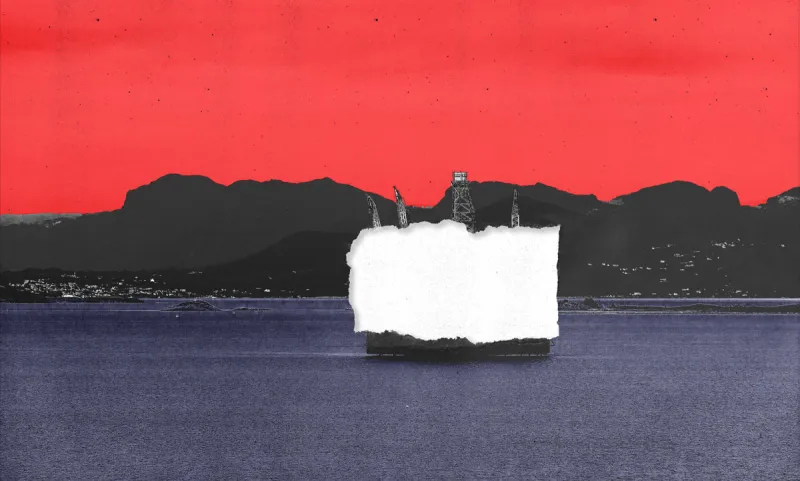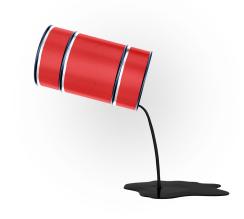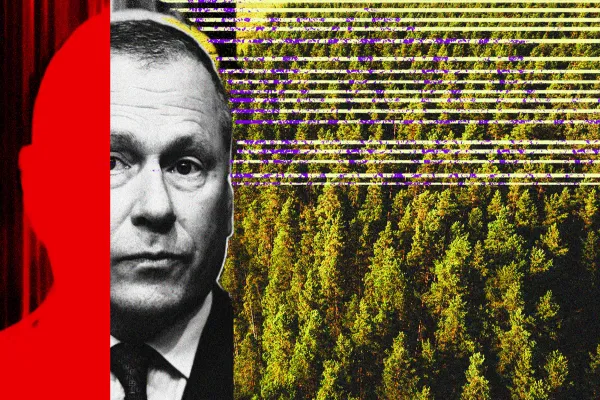
Illustrations by II.
Norway had reached nirvana — or it was having an existential crisis. Or so it seemed in November 2017, when the country made an unprecedented announcement that sent shares in global oil companies tumbling.
The country’s $1 trillion — yes, trillion — sovereign wealth fund, the Government Pension Fund Global, said it would abandon oil and gas companies, the equivalent of $35 billion in investments, to reduce its exposure to the very asset from which it derives its great wealth.
Environmentalists celebrated what they saw as the beginning of a divestment domino effect. Mindy Lubber, president of Ceres, a nonprofit that advocates for sustainable investing, described the decision as a “shot heard around the world.” Martin Norman, head of the sustainable finance campaign at Greenpeace Nordic, said: “These people move like lemmings; you see that through history. So when the Norwegian . . . fund does [divest], and the New York State [Insurance] Fund does too, things start happening faster.”
Yet nearly a year later, even Norway’s first domino has yet to fall. In August a committee of economists appointed by Norway’s Ministry of Finance published a second opinion: stay invested.
“There has not been an appetite to use the fund to achieve any goals other than earning money,” says Harald Magnus Andreassen, chief economist at SpareBank 1 Markets and one of the three economists who worked on the second opinion. Øystein Thøgersen, chair of the committee, said Norway’s exposure to oil is declining because the largest oil stocks have already been converted into financial assets. And thus, a year on, the fund’s managers and a younger generation of sustainability leaders are at loggerheads.
The battle over owning oil and gas stocks is all the more intense because of the irony underlying it.
Both parties, of course, know their trillion dollars isn’t derived from snow. Indeed, it is written in the common name of the fund, which is almost never referred to by its formal name. Norwegians, even as they talk of divestment, have another name for it: the oil fund.
But Instagram won’t show you what lies beneath this great beauty: billions upon billions upon billions of gallons of liquid gold.
For centuries this fishing nation didn’t know what lay beneath. Only in 1963 did the government proclaim sovereignty over the Norwegian continental shelf; it started awarding licenses to international companies to drill for oil in 1966, while retaining ownership of the land. Norway rapidly became Europe’s largest oil producer, and for 20 years this newfound wealth revitalized infrastructure and turbocharged the country’s development. As the surplus continued, the government came around to the idea of setting up a fund as a kind of national savings account to help smooth out revenues and hedge against fluctuations in the price of oil.
In 1996 the first transfers were made to the fund, which is owned by the Norwegian people and managed by the investment arm of the national bank, Norges Bank Investment Management.
Scientists now estimate that Norway is halfway through its reserves of oil. As it drills through the remainder — which is estimated to be gone by the middle of this century — the country’s economy is shifting away from a reliance on fossil fuels and toward the financial sector. As a result, the oil fund has gone from national savings account to the key to Norway’s future, with a value twice the present value of future oil and gas revenue and two and a half times Norway’s GDP.
Yet as the fund's importance to the Norwegian economy has grown, the debate about how to manage it has become increasingly fraught.
Terje Osmundsen worked on setting up the fund as state secretary of the prime minister’s office in the 1980s, when the Ministry of Finance was against the whole idea. “The ministry felt that they were much better just to keep doing like we did before and building up reserves and not identifying a special oil fund,” Osmundsen says. “That, of course, was not ungrounded. We saw what happened in other countries.”
Politicians spoke of the infamous Dutch disease, where the rapid development of one industry has a negative impact on the broader economy. The disease was identified in 1977, in The Economist, to describe the decline of the manufacturing sector in the Netherlands after the discovery of the large Groningen natural gas field in 1959. Economists noted a pattern: Countries with abundant resources tend to experience lower economic growth than those with fewer resources. As a result, the Norwegian government took precautions against the disease — mainly through the introduction of a fiscal rule limiting annual withdrawals to no more than 3 percent of the fund. In 2018 it will use 2.9 percent, or 231 billion kroner ($28 billion), to make up around 20 percent of the government’s annual budget. Annual returns have averaged 5.9 percent since 1998, adjusted to 4 percent after management costs and inflation. With very few exceptions, the fund has made net gains year-on-year.
Then there was the fear that a large fund could be manipulated for political ends.
“Many experts told us that it was a bit naive that a democratic society could manage such big cash flow in a sustainable way,” says Jens Stoltenberg, Norwegian prime minister from 2000 to 2001 and 2005 to 2013. The government knew it needed to be cautious: The world has plenty of oligarchies grown rich on oil at the expense of a nation.
But even Stoltenberg admits that Norway never expected the fund to get so big — or for its investments to be so successful.
It is now the world’s biggest sovereign wealth fund, leaving authoritarian regimes like those in Abu Dhabi and Beijing trailing in its wake. Terrified of corruption, Norwegian politicians and bankers talk about the fund’s future exclusively in financial terms. Opinions are exercised strictly with the aim of maximizing returns. Egil Matsen, deputy governor of Norges Bank, says, “Our advice just does not take a stand on environmental concerns related to oil and gas production or the sustainability of that sector.”
Yet the fund was able to take a stand against oil and gas stocks — not because of any environmental imperative, but precisely because of this logic.
Matsen was involved in the writing of the original opinion that the oil fund should divest its interests in oil. “When the oil price is falling, the return on the fund would be lower than it otherwise would have been,” he says from the boardroom table in his corner office at the bank’s headquarters. “Those are the periods where, also, the oil and gas revenues to the government will also suffer. So we think it's a good hedge to not include oil and gas stocks in the reference index.”
The scope of the second opinion was slightly different, Matsen says, which might explain why they reached a different conclusion. Neither opinion took into account environmental factors. “There is a discussion of [not] being invested in fossil fuels on ethical grounds,” Matsen says. “But that's outside the domain of the Norges Bank.”

Osmundsen, who pushed for the creation of the fund when he was in politics, now sees it going in a very different direction.
One recent morning, Osmundsen could be found leaping onstage at a breakfast debate. The early-morning discussion about whether the oil fund should include unlisted infrastructure investments was not hosted in a bank, or at parliament, but at Kulturhuset, a coworking space in central Oslo, where it was attended by throngs of young people in an exposed-brick event space decorated with glitter curtains and filament fairy lights. By the time Osmundsen interrupted the politicians onstage, many of the young students and teachers in the audience had been diligently scrawling notes on the issue for 90 minutes. “The oil fund is my pension, but I’m not thinking about that,” said one student in a rainbow headband. “I’m thinking about the environment.”
Osmundsen crashed the stage out of frustration with politicians who fail to see that the long-term financial performance of the fund depends on the environment. “It's not enough to say that you're not going to invest in fossil fuels,” he says later. “They need to invest in renewables to avoid the scenario of 3- to 4-degree [Celsius] heating in the middle of the century. That's only 30 or 40 years from now.”
Osmundsen now runs Empower New Energy, which finances infrastructure projects in developing countries. He agrees that the fund should not be used for political ends, but finds the financial arguments old fashioned and reductive. “We cannot look like Qatar, you know. Qatar is suddenly investing a huge part of their oil fund into one company, for instance,” he says. “But as an electorate we need to grow up to the fact that what we do has a very important impact.”
The oil fund is taking steps toward renewable investments — purely for financial reasons, of course. In 2018 the Norwegian parliament finally agreed the government should produce a mandate that would allow the oil fund to invest in unlisted renewable-energy projects such as solar and wind. This brings it in line with numerous other institutional investors and private equity funds such as Blackstone Group and PensionDanmark, a Danish pension fund with €32 billion ($36.7 billion) under management.
Each new asset class is scrutinized extensively. Since January, divisions have emerged in the Norwegian government over whether to allow the fund to invest in unlisted private equity. Not everyone believes the discussions are necessary or desirable. “It might be that the price of being a huge publicly owned fund is that you have to be 100 percent transparent in everything,” says SpareBank's Andreassen. “You can't go into some pockets around a couple of markets where we could earn some money, but where transparency is less. And that's the trade-off.”
When the world's biggest sovereign wealth fund flexes its muscle, the world feels the squeeze. Norway owns 1.3 percent of all global shares and 2.3 percent of all European shares. Its desire to be a responsible shareholder has recently outweighed even its desire for financial returns — just as oil is called into question.
The oil fund pulled out of tobacco companies in 2010, a decision that hit returns by 0.68 percent through 2015, the equivalent of $1.94 billion. By 2017 it had cut out nuclear weapons producers like Boeing Co., Airbus, and Lockheed Martin Corp., plus companies breaching human rights or causing environmental damage such as Walmart and Duke Energy, costing its equity benchmark 1.1 percentage points, the equivalent of $1.4 billion. At shareholder meetings the oil fund has started voting against companies such as Apple and Berkshire Hathaway. It opposed U.S. companies like General Electric Co. and Proctor & Gamble Co. when they attempted to combine the roles of chief executive and chair, and French drugmaker Sanofi and German software group SAP for high executive pay and taxation. When pressed, Andreassen concedes that in a few instances, the oil fund divests for what it calls “ethical reasons.”
“We got child labor,” he says. “We have some weapons and tobacco and coal too. We call it ethical reasons. But there has not been any appetite, at least so far, to use the same argument versus oil — I guess partly because we are a producer as well and that would be a paradox.”
Oil is so deeply ingrained in the Norwegian psyche that its exclusion from the fund is much harder for Norwegians to imagine. Yet the road is leading to its eventual exclusion — and a recent precedent paved the way to excluding fossil fuels.
In 2015 the oil fund divested from coal, after two years of campaigning by Greenpeace, the World Wildlife Fund, and Future in Our Hands — the same Norwegian NGO that organized the breakfast meeting at Kulturhuset about unlisted infrastructure investments. The oil fund now excludes 69 firms based on their dependence on thermal coal. The groups that won the victory on coal came together in the aftermath. “We said: ‘Let’s have a fossil-fuels-free fund by 2020!'” said Greenpeace's Norman.
Hilal Atici, global campaign strategist at Greenpeace International, said: “Getting the oil fund that was built on oil money to free itself from oil was a more difficult mental exercise. We really had to find the right rationale for the divestment. As we talked to people we realized that, despite the challenges, we could make it happen. But it would take time.”
Sony Kapoor, managing director of international think tank Re-Define, says Norway frequently falls back on discussions. “The prime minister talks about reducing exposure to oil, but no action is taken,” he says. “The oil lobby in a country such as Norway is exceedingly powerful and anything that is seen to be the thin end of the wedge — which is how this is perceived in Norwegian circles — becomes highly political.” (Erna Solberg, the Norwegian prime minister, and Siv Jensen, the finance minister, declined to comment for this article.)
“Norway has fallen prey to a ‘Norwegian disease’: the Dutch disease, but worse,” Kapoor says. “At least in the case of the Netherlands, when it let excessive dependence on gas suck the oxygen out of the rest of the economy, oil and gas were not sunset industries, as they are now. This Norwegian disease is Dutch disease on steroids.”
He has long called for Norway to champion efforts to challenge climate change. His work seemed prescient after oil prices plunged from $107 a barrel in May 2014 to $29 a barrel in January 2016, prompting Prime Minister Solberg to call for Norway to wean itself off oil. Norway staved off recession by making the first-ever net withdrawal from the oil fund and cutting interest rates, which left the country with the lowest real interest rates in the world.
At the same time, the Norwegian government was forging bold plans to reduce greenhouse emissions ahead of the Paris Climate Agreement coming into force in 2020. In 2015 the government promised to reduce greenhouse gas emissions by 40 percent by 2030, compared to 1990 levels. Since the Norwegian economy started growing again, and oil prices returned to $84 a barrel this month, the economic pressure for diversification has dropped off. The climate agenda has followed suit.
“The dissonance between the pro-green rhetoric from Norway and its actual policies is mind-boggling,” Kapoor says. “Norway has pledged to cut its domestic emissions by 40 percent by 2030, but at the same time, it is trying to maximize oil and gas exports, the emissions from which are ten times as big.” He notes that Norway has contributed more than 0.7 percent of all emissions since 1988, while having less than 0.07 percent of the world population.
Osmundsen says politicians are driven by short-term considerations, unlike the fund’s managers, who think in terms of generations. He points to examples of other fund managers playing the long game, such as the Canadian government pension fund, which is plugging C$3 billion ($2.3 billion) into renewable investments including wind, solar, and sustainable waste management, and a Danish industrial pension fund that doubled its investments in solar and wind in Japan, India, Thailand, and the Philippines between 2012 and 2015.
Paranoia about ceding political control of the fund prevents Norway from following suit, according to some critics. “There is a high level of mistrust between the finance ministry and the central bank,” Kapoor says. “If any change from a passive tracking strategy is allowed, that might result in political demands and discretionary investments, and at some point they might be held accountable.”
Norges Bank's Matsen denies there are misgivings between the bank and the finance ministry. “I would disagree strongly that there's a higher degree of mistrust,” he says. “Quite the opposite. We are very transparent about the results from our active management. The government evaluates those results on a regular basis.”
But the existing actively managed investments are a long way from what Osmundsen believes is necessary. He imagines a future in which the fund agrees, over the course of five years, to increase the share of renewable or low-carbon infrastructure assets under management from 1 percent to 4 percent. “It would have a huge impact, because the amounts are so enormous. It will set the standard,” he says.
When change does come, it will come in one of two ways familiar to those in this debate: the environment or the markets.
“We are witnessing the last cycle,” Osmundsen says. “At the same time, awareness of climate change is increasing every month, especially since the hot summer.” He believes that as climate change moves up the international agenda, it will also move up the Norwegian agenda.
Anja Bakken Riise, director at Future in Our Hands and host of the event at Kulturhuset, says some politicians are already taking a stand. “Norges Bank has been asking for facilitated infrastructure investments since 2006 and the Ministry of Finance has been blocking it,” she says. “But they are not blocking it anymore. They will serve a limited mandate.”
Riise points to the annual New Climate Economy report, which says the world needs $1 trillion in sustainable infrastructure every year through 2030 to reach the Paris Agreement's climate goals: “That is the size of a Norwegian oil fund every single year.”
Then there is the market. The oil fund’s strength is also its Achilles' heel. In March the fund estimated it could lose 40 percent of its value, the equivalent of $420 billion, in a single year in the event of a stock market crash, combined with an appreciation of the Norwegian krone. This is significantly more than the 23 percent lost during the 2008 downturn, given the fund is now four times its size in 2008.
SpareBank’s Andreassen is already considering taking his personal investments out of equities after noting that stock markets are looking pricey. “I haven't sold my portfolio yet in equities, but I'm thinking about it. I know I'm going to reduce,” he says. But he says it is simply impossible to adopt that strategy for the oil fund: “Perhaps I could take this brave decision that we want to go out of equities and reduce the portfolio from 70 percent down to 30. But that's a huge change. If I said that, the stock market might crash because we are so heavily invested in many companies. I can't do it.”
Eventually the two sides of the debate may discover they are closely linked. Scientists predict unprecedented devastation if global temperatures rise just 2 degrees Celsius by the end of the century. The hot summers will become unbearable, with an additional 420 million people facing heatwaves. The world’s coral reefs will be destroyed, wiping out ocean species. The seas will rise, putting the lives of 10 million more at risk from flooding.
Faced with global civil unrest, it may not seem like such a paradox for the world’s biggest oil fund to stop investing in oil.
“Sometimes I feel with this debate that we're trying to separate things that are inseparable,” says Riise of Future in Our Hands. Osmundsen agrees. “I think the fund’s agenda is actually the future of humankind,” he says, gathering his cycling helmet to go off and begin his day.
“If the future looks bleak," he says, "then the prospect for the fund is also bleak.”





